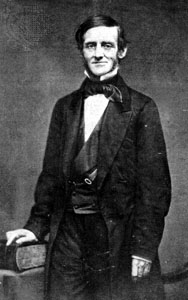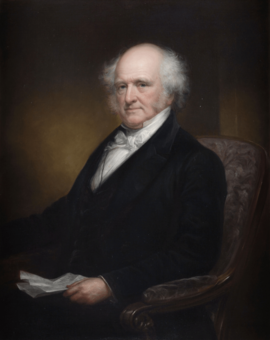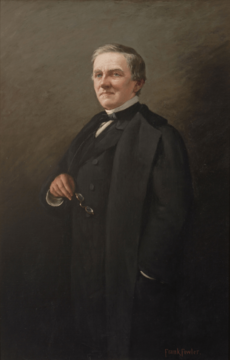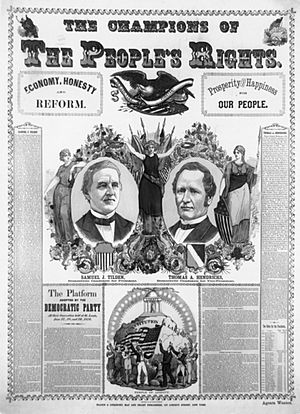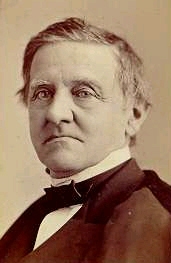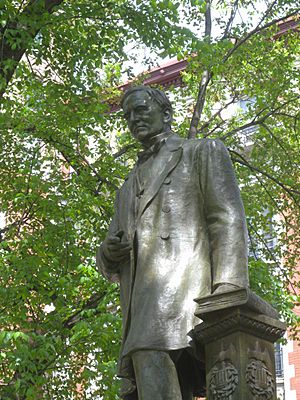Samuel J. Tilden facts for kids
Quick facts for kids
Samuel J. Tilden
|
|
|---|---|
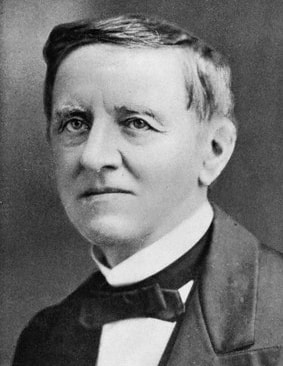 |
|
| 25th Governor of New York | |
| In office January 1, 1875 – December 31, 1876 |
|
| Lieutenant | William Dorsheimer |
| Preceded by | John Adams Dix |
| Succeeded by | Lucius Robinson |
| Member of the New York State Assembly from New York County's 18th district |
|
| In office January 1, 1872 – December 31, 1872 |
|
| Preceded by | Leander Buck |
| Succeeded by | Barney Biglin |
| Chair of the New York Democratic Party | |
| In office August 1866 – September 1874 |
|
| Preceded by | Dean Richmond |
| Succeeded by | Allen C. Beach |
| Member of the New York State Assembly from New York County |
|
| In office January 1, 1846 – December 31, 1847 Serving with 13 others
(Multi-member district) |
|
| Corporation Counsel of New York City | |
| In office 1843–1844 |
|
| Preceded by | Alexander W. Bradford |
| Succeeded by | Stephen Sammons |
| Personal details | |
| Born |
Samuel Jones Tilden
February 9, 1814 New Lebanon, New York, U.S. |
| Died | August 4, 1886 (aged 72) Yonkers, New York, U.S. |
| Resting place | Gov. Samuel J. Tilden Monument, Cemetery of the Evergreens New Lebanon, New York, U.S. |
| Political party | Democratic |
| Other political affiliations |
Free Soil (1848) |
| Education | Yale University New York University |
| Signature | |
Samuel Jones Tilden (born February 9, 1814 – died August 4, 1886) was an American politician. He served as the 25th Governor of New York. Tilden was also the Democratic candidate for president in the 1876 United States presidential election. This election was very controversial.
Tilden won the most votes from the public. However, he lost the election in the Electoral College. He is the only candidate to win a majority of the popular vote but still lose the presidency.
Samuel Tilden was born into a wealthy family in New Lebanon, New York. He was interested in politics from a young age. He became a close helper to Martin Van Buren, who was the eighth President of the United States. Tilden studied at Yale University and New York University School of Law. He then became a successful lawyer in New York City.
He worked to fight corruption in government. This made him a popular figure. His efforts against corruption helped him become governor.
Contents
Early Life and Education
Samuel Tilden was born on February 9, 1814. He was the youngest son of Elam and Polly Jones Tilden. His family had come to North America in 1634. Tilden's father knew many important politicians. One of them was President Martin Van Buren. Van Buren became Tilden's political hero.
Tilden was often sick when he was young. He spent a lot of time studying politics and reading books. His health problems meant he could not go to school regularly. He left Williams Academy and Yale College early.
Later, Tilden enrolled at New York University School of Law. He also studied law in a lawyer's office. He became a lawyer in 1841. Tilden became known as a very good corporate lawyer. He joined the Democratic Party. He often campaigned for Van Buren and other Democrats.
Early Political Career
In 1843, Tilden became New York City's legal advisor. This was a reward for his work for Governor William C. Bouck. He handled many cases for the city. But he left office in 1844 when a different party won the mayoral election.
Tilden was a delegate at the 1844 Democratic National Convention. This meeting chose the party's presidential candidate. He later served in the New York State Assembly. There, he helped solve the "Anti-Rent War." This was a conflict between farmers and landlords.
After 1846, Tilden left public office. He focused on his law practice. He became very successful and wealthy. He was known for helping struggling railroad companies. Many friends and politicians trusted him to manage their money.
Tilden was a leader of the "Barnburners." This group within the New York Democratic Party was against slavery. They wanted to stop slavery from spreading into new territories. Tilden helped create the Free Soil Party in 1848. This party nominated Van Buren for president. Van Buren's campaign helped the Whig Party win the 1848 election.
Unlike many anti-slavery Democrats, Tilden did not join the Republican Party in the 1850s. He did not have close ties with presidents Franklin Pierce or James Buchanan. In 1859, Tilden said he was "out of politics."
In the 1860 United States presidential election, Tilden was against Abraham Lincoln. He worried that Lincoln's election could lead to war. When the American Civil War began, Tilden supported the Union. He helped Horatio Seymour become governor in 1862. He also helped George B. McClellan get the Democratic presidential nomination in 1864.
In 1867, New York University gave Tilden an honorary law degree. He also became a delegate to the state's constitutional convention.
Fighting Corruption in New York
After the Civil War, Tilden became the head of the New York State Democratic Committee. He led Seymour's campaign in the 1868 United States presidential election. Seymour lost to Ulysses S. Grant.
After the election, Tilden stopped working with William M. Tweed. Tweed led a powerful political group called Tammany Hall. Tweed and his allies used bribery and favors to control New York City and the state. In 1871, Tweed's financial records were leaked. The New York Times began reporting on Tammany Hall's corruption. Tilden started his own investigation into Tweed's bank accounts.
Tilden ran for the New York State Assembly. He was part of a group of Democrats who opposed Tammany Hall. He said that anyone who cheated the people was not a true Democrat. Tilden and his allies won the 1871 state elections. Tweed was accused of many crimes. He later fled the state but was brought back to New York.
Tilden's role in stopping Tweed made him very popular. He was elected Governor of New York in 1874. As governor, he kept fighting corruption. He helped break up the "Canal Ring." This was a group of officials who overcharged for canal maintenance. Tilden became known across the country as a reform governor. This was important because President Grant's time in office had many scandals.
In 1875, Yale University also gave Tilden an honorary degree.
The Disputed 1876 Presidential Election
By 1876, Samuel Tilden was a top choice for the Democratic presidential nomination. People liked his reputation for fighting corruption. He had also won elections in New York, the most populated state. Tilden was a skilled organizer. He even predicted his own winning margin in the 1874 election very accurately.
The country was facing economic problems after the Panic of 1873. Democrats had different ideas about money. Some wanted to print more paper money (greenbacks). This would cause inflation and help farmers pay debts. Tilden, like most Republicans, believed the country should return to the gold standard. This meant money would be backed by gold. He thought this was the best way to fix the economy.
Tilden won the Democratic nomination on the second try. The convention chose Thomas A. Hendricks as his running mate. Hendricks supported printing more money, balancing the ticket. The Republicans nominated Rutherford B. Hayes. Many people thought Tilden would win the general election easily.
The General Election
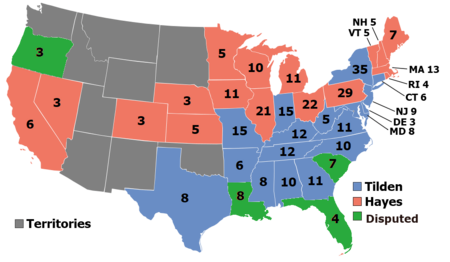
Both Tilden and Hayes did not campaign publicly. Their supporters did the campaigning for them. Tilden's campaign focused on "retrenchment and reform." They blamed high taxes and the current government for economic problems. Tilden promised to reform government jobs and support the gold standard.
Republicans reminded voters of Abraham Lincoln and the Civil War. They linked Democrats to slavery and disunion. Tilden denied he would pay the South for slaves or war losses. Many Southern Democrats wanted to end Reconstruction. They hoped to regain control of South Carolina, Florida, and Louisiana. White Southerners who supported Tilden used threats to stop African-American voters from voting. Tilden tried to distance himself from violent events like the Hamburg massacre.
Hayes won the West and much of the North. Tilden won New York, New Jersey, Indiana, and Connecticut. He also won the border states and most of the South. Tilden won the popular vote by 250,000 votes. He had 184 electoral votes, just one short of winning.
On November 6, newspapers reported Tilden had won. But Hayes could still win if he got all the electoral votes from Florida, South Carolina, and Louisiana. Hayes did not officially give up. Tilden told his supporters to stay calm and avoid violence. Both parties worried the dispute could lead to fighting.
The Electoral Commission

On January 26, Congress created a 15-member Electoral Commission. This group would settle the dispute over the electoral votes. It had five Democrats, five Republicans, and five Supreme Court justices. Two justices were Democrats, two were Republicans, and the fifth was chosen by the other four.
Tilden did not want the commission. He hoped the House of Representatives would decide the election. But he could not stop Democrats in Congress from voting for it. The fifth justice chosen was Joseph P. Bradley, a Republican. The commission voted 8 to 7, along party lines, to give all the disputed electoral votes to Hayes.
Even after the commission's decision, the House of Representatives could have stopped Hayes from becoming president. But many House Democrats agreed to accept the results. This was part of the Compromise of 1877. In this agreement, Democrats accepted Hayes as president. In return, federal troops were removed from the South. This ended the Reconstruction Era.
On March 2, Congress declared Hayes the winner. Hayes became president on March 4. He removed the last federal soldiers from the South in April 1877.
Some Democrats wanted Tilden to reject the results. But Tilden refused. He said he was happy to retire. He felt he would be remembered as the true winner. Tilden was the second person to lose a presidential election despite winning the popular vote. He is the only one to win a clear majority of the popular vote and still lose.
Later Life and Legacy
After the 1876 election, Tilden was expected to run again in 1880. He did not run for governor in 1879. He focused on gaining support for the presidency. However, his health problems and some new information about the 1876 election hurt his standing.
Before the 1880 Democratic convention, Tilden sent a letter. He suggested his health might stop him from running. The New York delegates thought he was withdrawing. They chose another candidate. The party nominated Winfield Scott Hancock, who lost the election.
Tilden also declined to run in 1884 due to poor health. He supported New York Governor Grover Cleveland. Cleveland won the Democratic nomination and became president.
Retirement and Death
Tilden retired in the early 1880s. He lived a quiet life at his estate, Greystone, in Yonkers, New York. He died there on August 4, 1886, at age 72. He is buried in New Lebanon, New York. His gravestone says, "I Still Trust The People," referring to the 1876 election.
Tilden left most of his large fortune to create a free public library in New York City. His relatives challenged his will. But about $3 million of his money still went to this purpose. In 1895, his trust combined with other libraries to form the New York Public Library. The building still has his name on its front.
Legacy
The Samuel J. Tilden House in Gramercy Park South is now used by the National Arts Club. Tilden's Greystone estate is now Untermyer Park. It was added to the National Register of Historic Places in 1974.
Several places are named after Tilden. These include towns like Tilden, Wisconsin, Tilden, Nebraska, and Tilden, Texas. There are also places like Samuel J. Tilden High School and Fort Tilden, New York. The Root-Tilden-Kern Scholarship is also named in his honor.
See also
 In Spanish: Samuel J. Tilden para niños
In Spanish: Samuel J. Tilden para niños


